Directional Paging for 5G Communications Based on Partitioned User ID
Abstract
1. Introduction
- The same paging message that is transmitted over several beams is majorly comprised of UE IDs of all the UE, configured in the PO. In PIDP, we propose to reduce the number of UE ID bits included in the paging message to reduce the overall paging resource overheads of the network.
- We present a novel method for the configuration of POs in the IDRX cycle and an effective distribution of UE over various POs. The proposed configuration of POs in PIDP ensures that the network is able to page all the UE uniquely despite the fact that only partial UE IDs are transmitted in the paging message.
- We perform numerical analysis to ascertain the advantages of PIDP. Paging resource overheads, the number of bits and time slots required for paging transmission and, subsequently, the base station’s power saving gain are analyzed with respect to variations in the number of beams and paging rate. Recent 5G parameters are considered for the analysis. We compare our proposed PIDP mechanism to directional paging transmission with full UE ID. The proposed PIDP mechanism manifests more than a power saving gain compared to directional paging transmission while using the full UE ID.
2. Related Work
2.1. Paging Monitoring by the UE
2.2. Paging Broadcast by the Network
3. Proposed PIDP Paging
- Partitioning: The first step of the PIDP mechanism involves partitioning of Nbits of the UE ID into two parts. UE ID Part 1 is comprised of the least significant bits of the UE ID. UE ID Part 2 is made up of the most significant bits of the UE ID. and together provide the complete information of the UE ID as shown in Figure 3.We propose that only UE ID Part 2 (comprised of bits) is transmitted in the paging message instead of the entire N bits. Since several UE are configured in each PO and there are multiple POs per IDRX cycle, the reduction in bits to be transmitted per UE would result in the saving of network resources. Moreover, the savings is expected to be substantial as the same paging message is transmitted over several beams.
- Configuring: It is not always possible to page all UE in the same PO, and it depends on factors like paging load, tracking area size and user density. Thus, multiple POs are required in each IDRX cycle. Since the network is aware of paging load and other factors, it configures numerous POs in the LTE/LTE (A) system. In directional paging, as well, multiple POs would be required for the same reasons. However, in the PIDP mechanism, we propose that the network configures multiple POs in each IDRX cycle based on bits (that is, UE ID Part 1). Let be the number of POs that can be configured per IDRX cycle in PIDP, and it is evaluated as:where are the number of bits by which each UE ID size is cropped. The POs are subsequently mapped to all the possible bit configurations that can be attained using bits. Thus, distinct PO in the IDRX cycle has a distinct bit configuration associated with it. Unlike PO/PF evaluation in LTE (Section 2.2), in the PIDP mechanism, we propose a novel and simplified mapping between POs and the least significant bits of the UE ID.
- Distributing: In the legacy system, multiple POs are configured by the network in the IDRX cycle, and the UE are distributed over these POs. Similarly, in the PIDP mechanism, the UE are distributed over number of POs configured for each IDRX cycle. We propose that the UE with the same least significant bits are configured in the same PO. Thus, in PIDP, while only most significant bits of the UE ID (Part 2) are included in the paging message, least significant bits (Part 1) are used to distribute the UE over different POs. This ensures that the IDs of all the UE that are paged are uniquely identified by the network even though only partial bits are included in the paging message.
PIDP System Model
4. Performance Analysis and Results
5. Conclusions
Author Contributions
Acknowledgments
Conflicts of Interest
References
- Agiwal, M.; Roy, A.; Saxena, N. Next generation 5G wireless networks: A comprehensive survey. IEEE Commun. Surv. Tutor. 2016, 18, 1617–1655. [Google Scholar] [CrossRef]
- Andrews, J.G.; Buzzi, S.; Choi, W.; Hanly, S.V.; Lozano, A.; Soong, A.C.K.; Zhang, J.C. What will 5G be? IEEE J. Sel. Areas Commun. 2014, 32, 1065–1082. [Google Scholar] [CrossRef]
- Kutty, S.; Sen, D. Beamforming for millimeter wave communications: An inclusive survey. IEEE Commun. Surv. Tutor. 2016, 18, 949–973. [Google Scholar] [CrossRef]
- Oh, S.-M.; Kang, S.-Y.; Go, K.-C.; Kim, J.-H.; Park, A.-S. An enhanced handover scheme to provide the robust and efficient inter-beam mobility. IEEE Commun. Lett. 2015, 19, 739–742. [Google Scholar] [CrossRef]
- 3GPP. Study on New Radio (NR) Access Technology; Physical Layer Aspects. 3GPP TR 38.802 v2.0. 2017. Available online: https://portal.3gpp.org/ (accessed on 4 June 2018).
- Elnashar, A.; El-Saidny, M.A. Extending the battery life of smartphones and tablets: A practical approach to optimizing the LTE network. IEEE Veh. Technol. Mag. 2014, 9, 38–49. [Google Scholar]
- Kwon, S.-W.; Hwang, J.; Agiwal, A.; Kang, H. Performance analysis of DRX mechanism considering analogue beamforming in millimeter-wave mobile broadband system. In Proceedings of the IEEE Globecom Workshops, Austin, TX, USA, 8–12 December 2014; pp. 802–807. [Google Scholar]
- 3GPP. Study on New Radio Access Technology Radio Interface Protocol Aspects; 3GPP TR 38.804. 2016. Available online: https://portal.3gpp.org/ (accessed on 4 June 2018).
- Chang, C.-W.; Chen, J.-C. UM paging: Unified M2M paging with optimal DRX cycle. IEEE Trans. Mob. Comput. 2017, 16, 886–890. [Google Scholar] [CrossRef]
- Agiwal, M.; Saxena, N.; Roy, A. Mobile assisted directional paging for 5G communications. Trans. Emerg. Telecommun. Technol. 2018, 29, e3270. [Google Scholar] [CrossRef]
- Berrocal-Plaza, V.; Vega-Rodriguez, M.A.; Sanchez-Perez, J.M. An efficient way of assigning paging areas by using mobility models. IEEE/ACM Trans. Netw. 2016, 24, 3726–3739. [Google Scholar] [CrossRef]
- 3GPP. E-UTRA-UE Procedures in Idle Mode. 3GPP TS 36.304 v14.5.0. 2017. Available online: https://portal.3gpp.org/ (accessed on 4 June 2018).
- Maitra, M.; Saha, D.; Bhattacharjee, P.S.; Mukherjee, A. An intelligent paging strategy using rule-based AI technique for locating mobile terminals in cellular wireless networks. IEEE Trans. Veh. Technol. 2008, 57, 1834–1845. [Google Scholar] [CrossRef]
- Toril, M.; Luna-Ramírez, S.; Wille, V. Automatic replanning of tracking areas in cellular networks. IEEE Trans. Veh. Technol. 2013, 62, 2005–2013. [Google Scholar] [CrossRef]
- Pacheco-Paramo, D.; Akyildiz, I.F.; Casares-Giner, V. Local anchor based location management schemes for small cells in HetNets. IEEE Trans. Mob. Comput. 2016, 15, 883–894. [Google Scholar] [CrossRef]
- Chang, C.-W.; Chen, J.-C. Adjustable extended discontinuous reception cycle for idle-state users in LTE-A. IEEE Commun. Lett. 2016, 20, 2288–2291. [Google Scholar] [CrossRef]
- Liou, R.-H.; Lin, Y.-B.; Tsai, S.-C. An investigation on LTE mobility management. IEEE Trans. Mob. Comput. 2013, 12, 166–176. [Google Scholar] [CrossRef]
- Cheng, R.-G.; Al-Taee, F.M.; Chen, J.; Wei, C.-H. A dynamic resource allocation scheme for group paging in LTE-advanced networks. IEEE Internet Things J. 2015, 2, 427–434. [Google Scholar] [CrossRef]
- Balasubramanya, N.M.; Lampe, L.; Vos, G.; Bennett, S. DRX with quick sleeping: A novel mechanism for energy-efficient IoT using LTE/LTE-A. IEEE Internet Things J. 2016, 3, 398–407. [Google Scholar] [CrossRef]
- Balasubramanya, N.M.; Lampe, L.; Vos, G.; Bennett, S. On timing reacquisition and enhanced primary synchronization signal (ePSS) design for energy efficient 3GPP LTE MTC. IEEE Trans. Mob. Comput. 2017, 16, 2292–2305. [Google Scholar] [CrossRef]
- Tang, L.; Shi, H.Y.; Chen, Q.B. Self-adaptive power saving mechanism for M2M. In Proceedings of the 5th IET International Conference on Wireless, Mobile and Multimedia Networks (ICWMMN), Beijing, China, 22–25 November 2013. [Google Scholar]
- Maheshwari, M.K.; Agiwal, M.; Saxena, N.; Roy, A. Hybrid directional discontinuous reception (HD-DRX) for 5G communication. IEEE Commun. Lett. 2017, 21, 1421–1424. [Google Scholar] [CrossRef]
- Agiwal, M.; Maheshwari, N.; Saxena, N.; Roy, A. Directional-discontinuous reception (D-DRX) for 5G wireless communications. Electron. Lett. 2016, 52, 1816–1818. [Google Scholar]
- Bagaa, M.; Taleb, T.; Ksentini, A. Efficient tracking area management framework for 5G networks. IEEE Trans. Wirel. Commun. 2016, 15, 4117–4131. [Google Scholar] [CrossRef]
- Agiwal, M.; Saxena, N.; Roy, A. Mobile assisted directional paging (MADP) in emerging 5G wireless networks. IEEE Wirel. Commun. Lett. 2017, 1–4. [Google Scholar] [CrossRef]
- 3GPP. Evolved Universal Terrestrial Radio Access (E-UTRA); Radio Resource Control (RRC); Protocol Specification. 3GPP TS 36.331 v13.0.0. 2016. Available online: https://portal.3gpp.org/ (accessed on 4 June 2018).
- ITU-R M. [IMT-2020.TECH PERF REQ]. Minimum Requirements Related to Technical Performance for IMT-2020 Radio Interface(s), ITU-R SG05. 2017. Available online: https://www.itu.int/md/R12-SG05-C/en (accessed on 4 June 2018).
- Sesia, S.; Baker, M.; Toufik, I. LTE-the UMTS Long Term Evolution: From Theory to Practice; John Wiley & Sons: Hoboken, NJ, USA, 2011. [Google Scholar]
- Pedersen, K.I.; Berardinelli, G.; Frederiksen, F.; Mogensen, P.; Szufarska, A. A flexible 5G frame structure design for frequency-division duplex cases. IEEE Commun. Mag. 2016, 54, 53–59. [Google Scholar] [CrossRef]
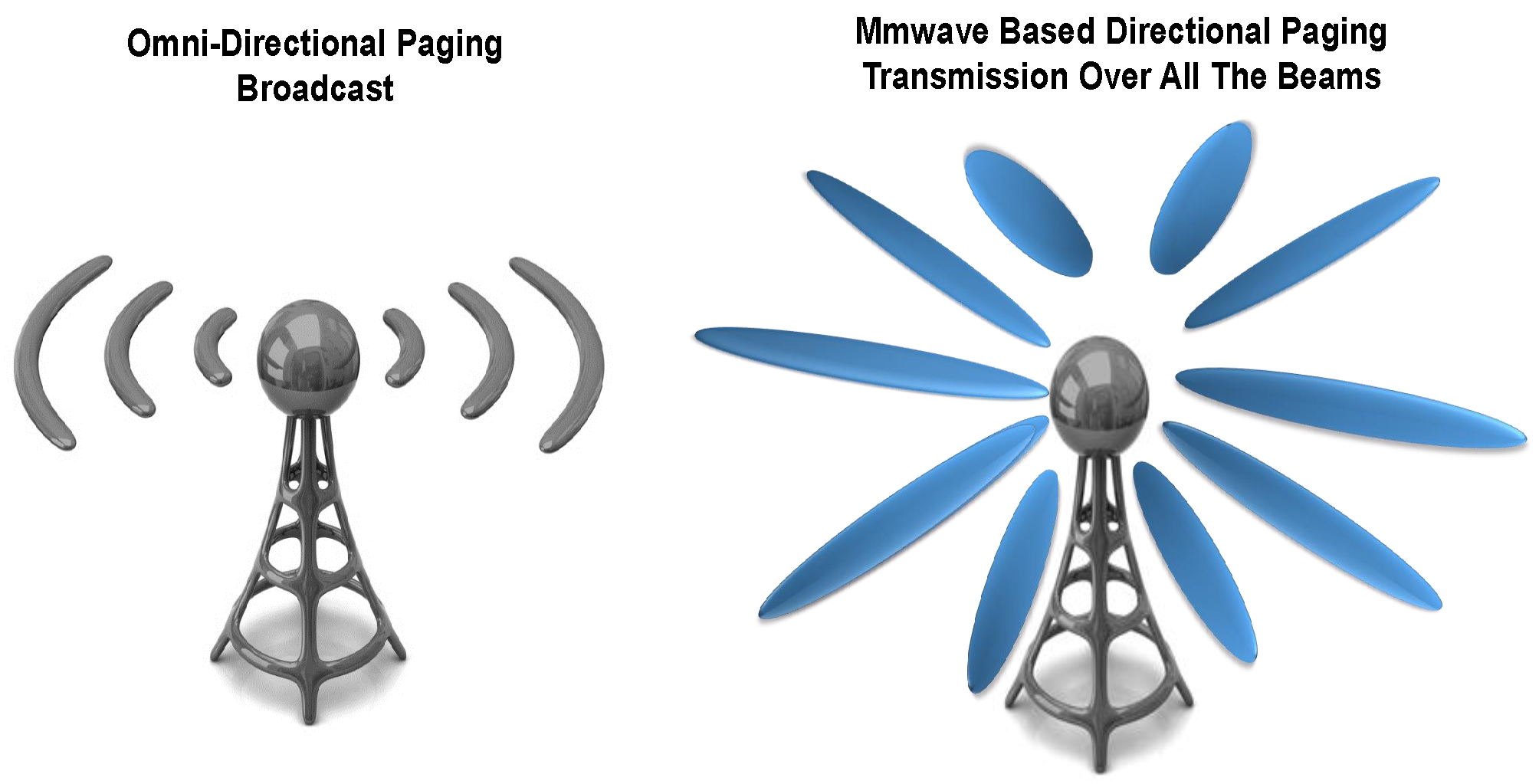
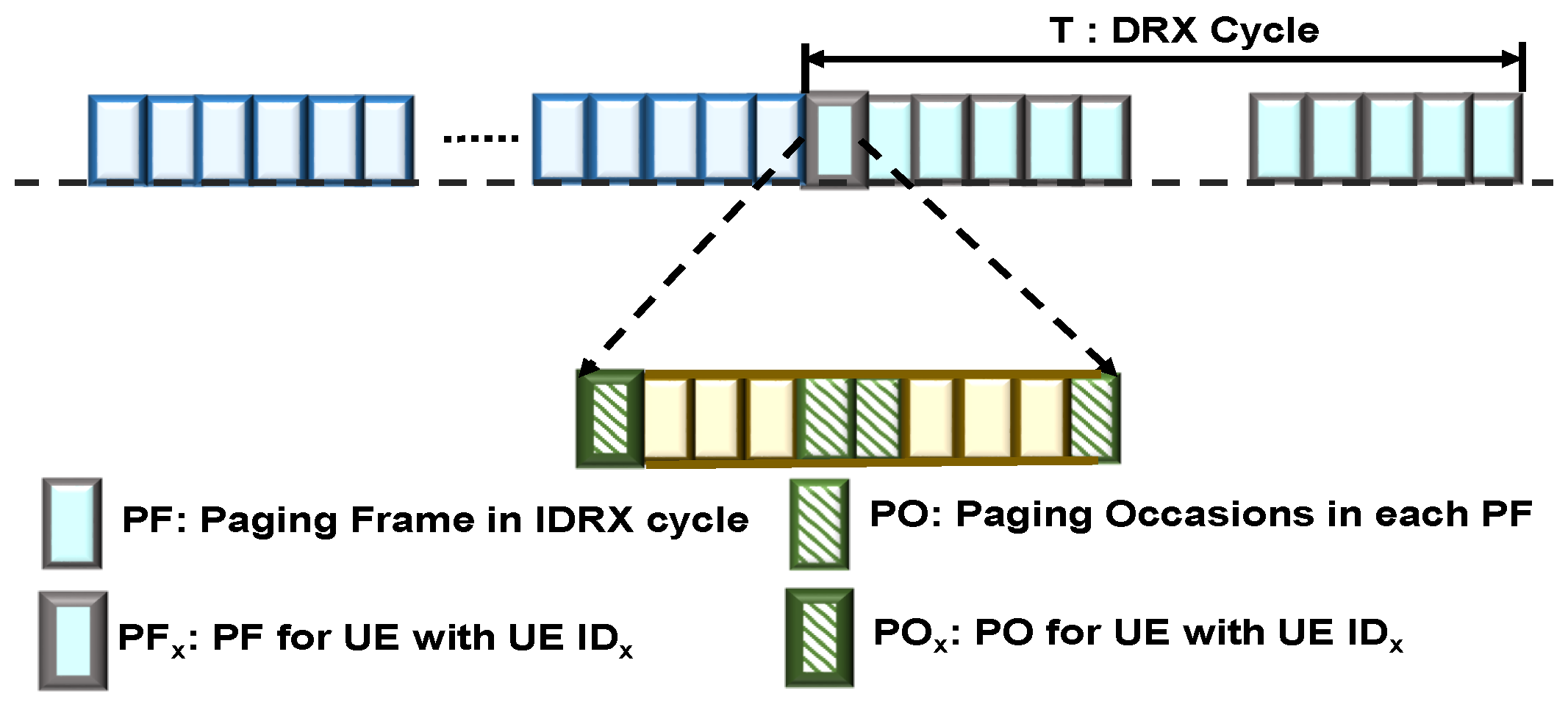
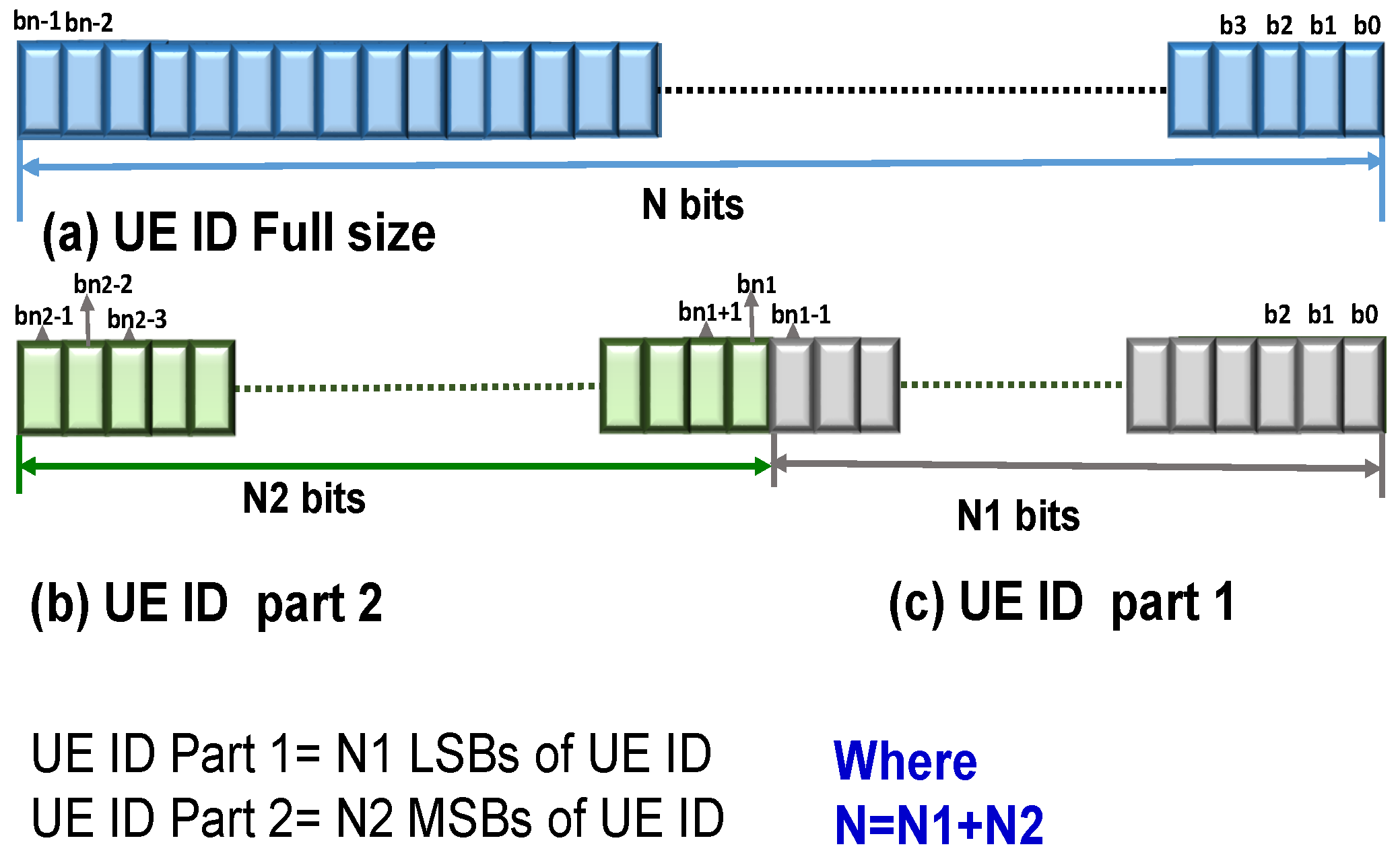
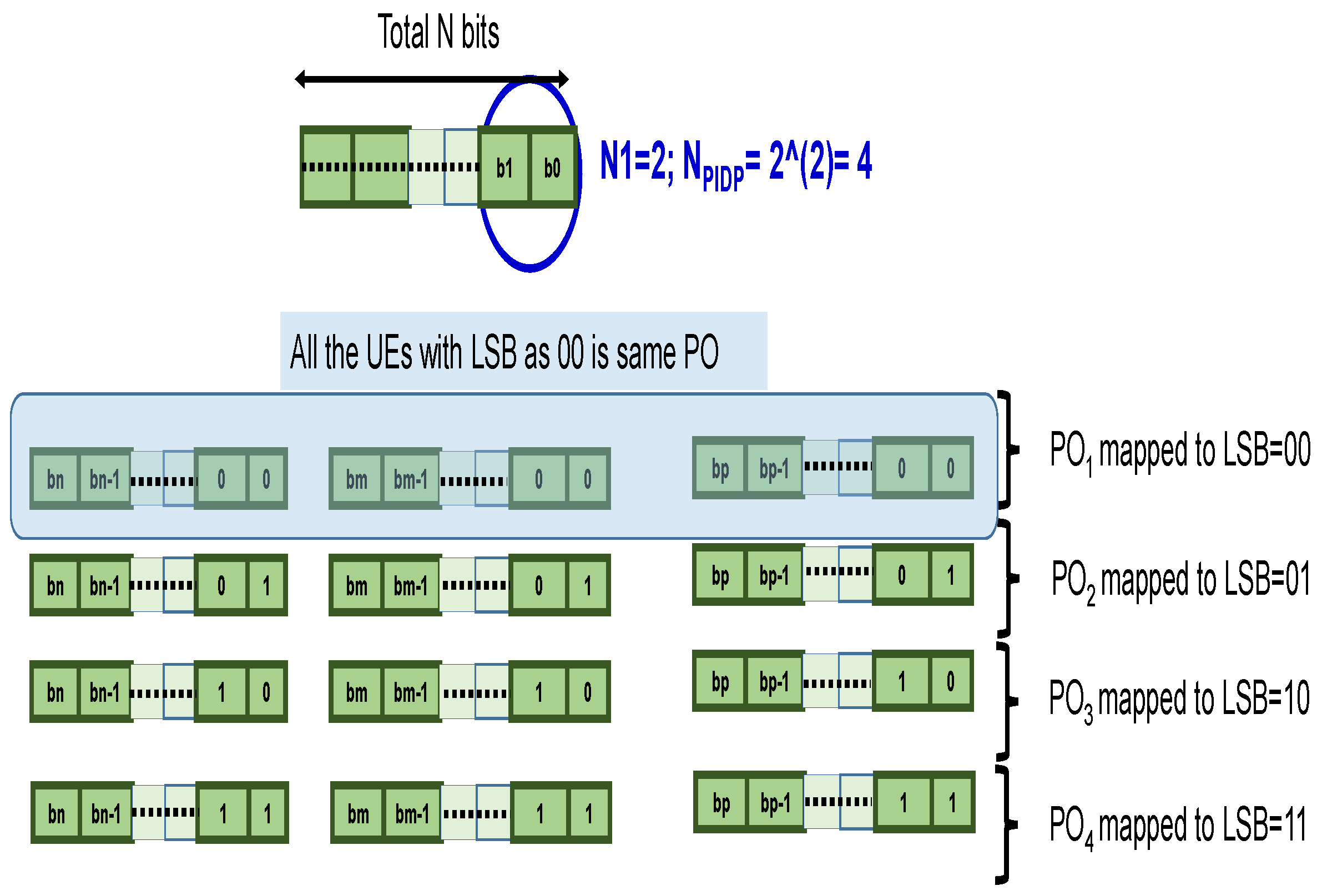
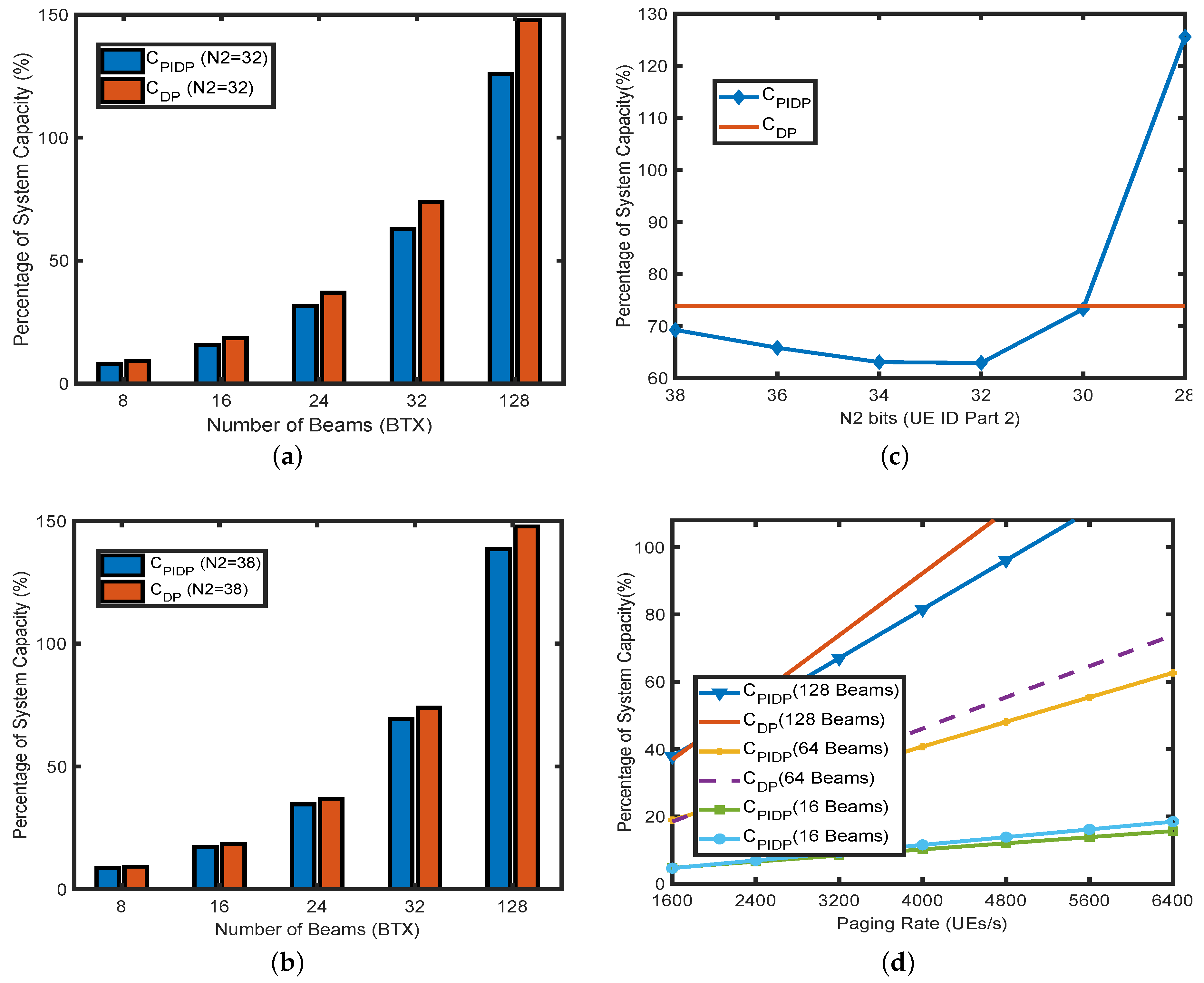
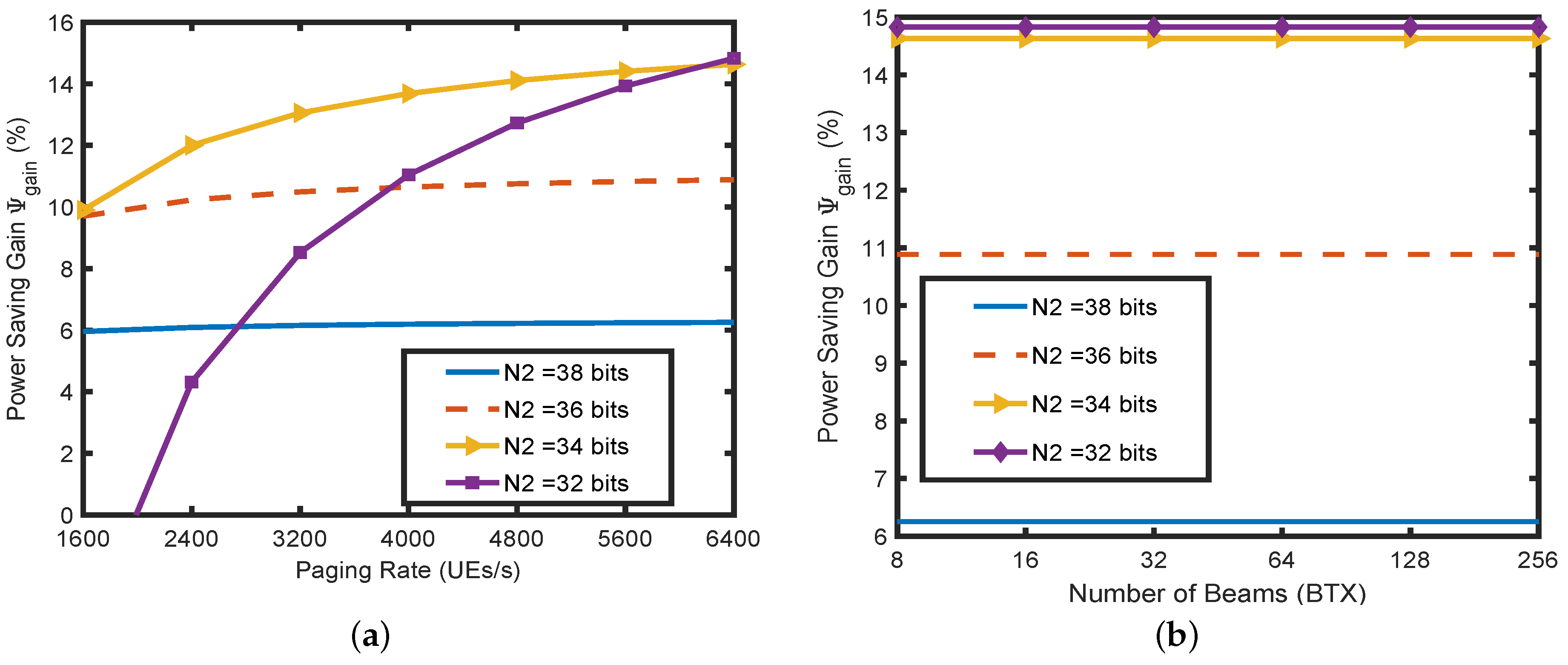
| Number of Beams | 16 | 32 | 64 | LTE |
| System Capacity for Paging (%) | 23.6 | 47.2 | 94.4 | 1.47 |
| Work Area | Recent Research Works |
|---|---|
| Paging and tracking area | Mobility model for paging area [11] Rule-based artificial intelligence [13] Multilevel graph partitioning [14] Anchor-based location in HetNets [15] Optimal adjustable extended DRX [16] Interacted cell concept [17] |
| Paging in MTC and IoT | LTE Group paging for MTC [18] DRX with quick sleeping [19] Reacquisition and synchronization [20] Self-adaptive DRX mechanism [21] |
| DRX and 5G | Tracking area management for 5G [24] Directional DRX (DDRX) for 5G [23] Hybrid-DDRX [22] Mobile-assisted directional paging [25] |
| Parameters | Value |
|---|---|
| Full UE ID Size (N) | 40 bits [26] |
| Cropped UE Size () | 28, 30, 32, 34, 36, 38 bits |
| Paging Rate, () | 1600–6400 UE/s [26] |
| Number of Beams () | 16, 32, 64, 128 beams [8] |
| System Bandwidth, () | 100 MHz [5] |
| Cell Edge Spectral Efficiency, () | 0.225 bits/s/Hz [27] |
| CRC + PDCCH + RRC bits () | 64 bits [28] |
| Time Slot Duration (T) | 0.2 ms [29] |
© 2018 by the authors. Licensee MDPI, Basel, Switzerland. This article is an open access article distributed under the terms and conditions of the Creative Commons Attribution (CC BY) license (http://creativecommons.org/licenses/by/4.0/).
Share and Cite
Agiwal, M.; Jin, H. Directional Paging for 5G Communications Based on Partitioned User ID. Sensors 2018, 18, 1845. https://doi.org/10.3390/s18061845
Agiwal M, Jin H. Directional Paging for 5G Communications Based on Partitioned User ID. Sensors. 2018; 18(6):1845. https://doi.org/10.3390/s18061845
Chicago/Turabian StyleAgiwal, Mamta, and Hu Jin. 2018. "Directional Paging for 5G Communications Based on Partitioned User ID" Sensors 18, no. 6: 1845. https://doi.org/10.3390/s18061845
APA StyleAgiwal, M., & Jin, H. (2018). Directional Paging for 5G Communications Based on Partitioned User ID. Sensors, 18(6), 1845. https://doi.org/10.3390/s18061845




